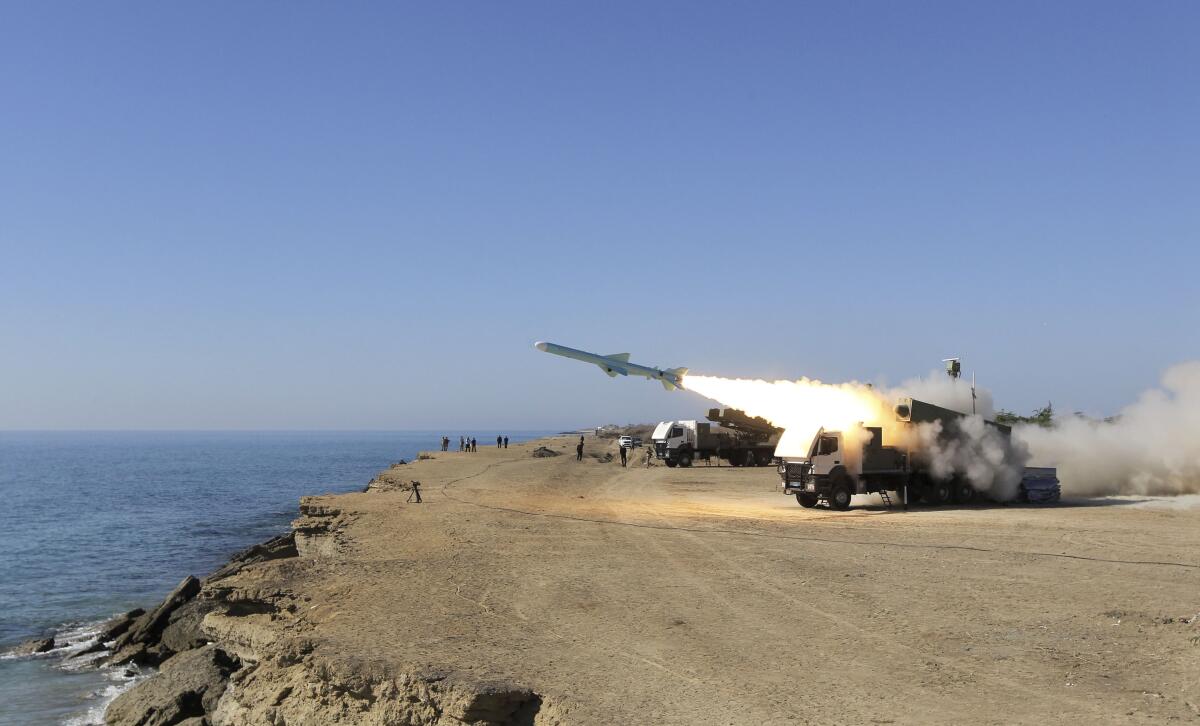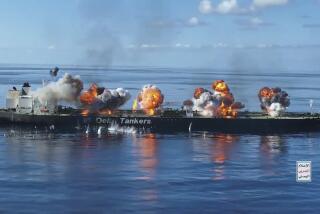Iranian missile strikes own ship, killing 19 sailors and wounding 15

- Share via
TEHRAN — A missile fired during an Iranian training exercise mistakenly struck a naval vessel instead of its intended target in waters near the strategic Strait of Hormuz, killing 19 sailors and wounding 15 others, Iranian authorities said Monday.
The bungled training exercises took place Sunday and raised new questions about the readiness of the Islamic Republic’s armed forces amid heightened tensions with U.S., just months after they accidentally shot down a Ukrainian jetliner near Tehran, killing 176 passengers.
It also comes soon after a tense naval encounter between Iranian and U.S. forces in the nearby Persian Gulf.
President Trump withdrew the U.S. from Tehran’s nuclear deal with world powers two years ago, launching a maximum pressure campaign against Iran that has pushed the archrivals to the verge of conflict repeatedly.
Analysts have warned regional tensions likely will increase again. This week also marks the one-year anniversary of attacks on oil tankers near the strait that the U.S. blamed on Iran.
Sunday’s friendly fire incident struck the Iranian navy vessel Konarak near the port of Jask, some 790 miles southeast of Tehran in the Gulf of Oman, the Iranian army said in a statement. Iran’s regular navy typically patrols those waters, while vessels from the paramilitary Revolutionary Guard usually patrol the Persian Gulf.
The Konarak, a Hendijan-class support ship taking part in the exercise, came too close to a target and the missile struck it, state TV said. Authorities did not identify the ship that fired the missile, though semiofficial media in Iran identified it as the Iranian destroyer Jamaran.
The Konarak had been putting out targets for other ships to target, state TV said.
Initially, officials said only one sailor had been killed. That number quickly changed to 19. A local hospital admitted 12 sailors and treated three more with slight wounds, the state-run IRNA news agency reported.
Iranian vessels towed the Konarak into a nearby naval base after the strike. A photograph released by the Iranian army showed burn marks and some damage to the vessel, though the military did not immediately offer detailed photographs of the site of the missile’s impact.
Iranian king Mohammad Reza Shah Pahlavi had purchased the Dutch-made, 155-foot vessel just before being toppled by the 1979 Islamic Revolution. The Konarak entered service in 1988 and crews later overhauled the vessel some 30 years later, making it able to launch sea and anti-ship missiles. Iran still relies on weaponry purchased under the shah due to international sanctions.
The boat typically carried a crew of 20 and authorities did not explain why it had 34 people on board at the time of the missile strike. The army identified those slain as including officers and enlisted men, including a combat diver.
It appeared the sailors may have been firing Noor anti-ship missiles during the exercise, said Reed Foster, a senior analyst at Jane’s. He said a replacement for the vessel “will likely take years to come into service” and represented a blow to the navy as Iran already saw a destroyer sink in the Caspian Sea in January 2018.
“Perhaps the greatest impact to the Iranian military and government is that this is the second high-profile incident in less than half a year where mistakes in missile targeting have resulted in significant loss of life,” Foster said.
Foster added that the friendly fire incident “damages the credibility” of the Iranian military and government’s claim that it can develop sophisticated defense weapons despite international sanctions.
This likely will provide new fodder for the U.S., which has been actively campaigning to keep a United Nations arms embargo in place on Iran that is due to expire in November.
Iran regularly holds exercises in the Gulf of Oman, which is close to the Strait of Hormuz, the narrow mouth of the Persian Gulf through which 20% of the world’s oil trade passes.
The U.S. Navy’s 5th Fleet, which monitors the region, did not respond to a request for comment.
Tensions had been expected to rise, however, after Iran’s government overcame the initial chaos that engulfed its response to the coronavirus pandemic. In April, the U.S. accused Iran of conducting “dangerous and harassing” maneuvers near American warships in the northern Persian Gulf. Iran also had been suspected of briefly seizing a Hong Kong-flagged oil tanker just before that.
“Potential exists for a limited direct conflict, even though neither side wants one,” the Tel Aviv-based Institute for National Security Studies said.
More to Read
Sign up for Essential California
The most important California stories and recommendations in your inbox every morning.
You may occasionally receive promotional content from the Los Angeles Times.










